I was skeptical at first, thinking how beer and cheese would taste in bread. But, man, it's a game-changer! It was so different and delicious. Even my neighbor wanted the recipe.
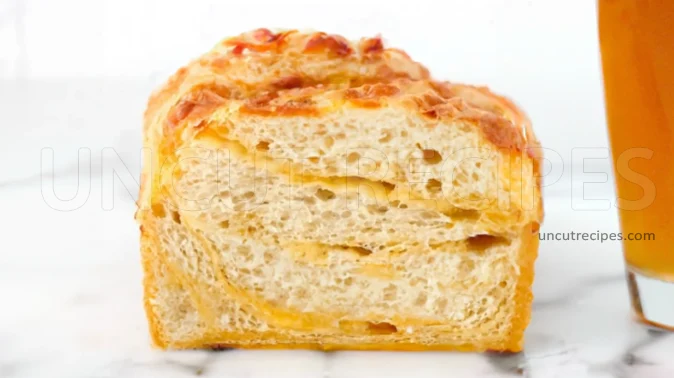
A symphony of flavors! Beer and cheese, two staples that have been loved by many for ages, find themselves united in a loaf of bread that's bound to become the talk of the table.
Imagine biting into a slice where the deep notes of beer dance harmoniously with the rich tones of cheese, delivering a culinary experience that feels both familiar and brand new.
This Bread Machine Beer Cheese Bread is not just a recipe; it's an adventure. An adventure where two iconic flavors meet and meld in the cozy embrace of warm, freshly baked bread. No need for a special occasion to whip this up; every day is a good day for Beer Cheese Bread.
So, let's roll up those sleeves and let the bread machine work its magic, while we await a treat that's sure to delight our taste buds. Let the baking begin!
JUMP TO:
INGREDIENTS:
Beer Choice: The choice of beer can significantly influence the bread's final taste. A darker beer often results in a more flavorful and rich bread, while a lighter beer gives a subtle hint of maltiness.
- Brands like Budweiser or Heineken offer a lighter, crisper taste which can result in a milder bread flavor.
- Samuel Adams Boston Ale or Sierra Nevada Pale Ale have a richer flavor which can give the bread a deeper beer essence.
- If you want a robust, deep flavor, go for brands like Guinness or Deschutes Black Butte Porter. This will provide your bread with a malty, almost chocolaty undertone.
Cheese Variations: Different cheeses not only vary in taste but also in texture when melted. Some cheeses, like cheddar, provide a strong flavor, while others, like mozzarella, offer more texture than taste. Combining cheeses or picking one that complements the beer's flavor can result in a more harmonized final product.
- Mild Cheddar: A processed cheese that melts smoothly. Its mild flavor pairs well with many beer types without overpowering the beer's taste.
- Monterey Jack: Known for its mild flavor and exceptional melting qualities. Brands like Kraft or Sargento are reliable choices.
- Sharp Cheddar: Brands like Cabot or Tillamook offer a tangy flavor, enhancing the bread's overall taste profile. This cheese might be a bit more dominant in flavor compared to American or Monterey Jack.
- Mozzarella: Brands such as Galbani or BelGioioso provide a milder flavor with excellent meltiness. While it's traditionally used in Italian dishes, its neutral taste can pair well with the beer in this recipe.
- Pepper Jack: If you fancy a bit of spice, brands like Horizon Organic can be an option. The slight heat from the peppers can contrast nicely with the maltiness of the beer.
MAIN STEPS:
Temperature Management, Protecting Yeast Viability: While the idea of infusing beer and cheese flavor directly through warming might sound intriguing, it's paramount to ensure the mixture isn't too hot. Excessive heat can deactivate the yeast, leading to a dense loaf. Aim for a lukewarm temperature, similar to a comfortable bathwater feel. If uncertain, use a kitchen thermometer; anything above 110°F (43°C) can risk damaging the yeast.
Shredding vs. Dicing Cheese, Textural Impacts: When preparing your cheese, consider the texture you desire. Shredded cheese disperses more evenly throughout the bread, giving a uniform taste. On the other hand, dicing provides pockets of cheesy delight that burst with flavor as you bite into them. Both methods are valid; it depends on your preference.
Wire Rack Cooling, Don't Skip This Step: It may be tempting to slice into that warm, fragrant loaf immediately after it's out of the machine. However, allowing it to cool on a wire rack is vital. This ensures the bread's interior finishes its cooking process, and the crust doesn't turn soggy from trapped steam. If you're in a hurry, placing the cooling rack in a well-ventilated area or near an open window can expedite the process.
Alternative Method, Oven Finish for a Crisper Crust: If you fancy a crustier exterior, consider using the bread machine only for kneading and the first rise. Once the dough is ready, shape it, place in a loaf pan, let it rise again, and bake in a preheated oven at 375°F (190°C) for 25-30 minutes or until the bread sounds hollow when tapped. This method often results in a crispier crust, reminiscent of traditional oven-baked breads.
SERVED WITH:
Starter: Welsh Rarebit (United Kingdom): A delightful dish made from a savory sauce of melted cheese and various other ingredients, typically served hot over toasted bread. Its cheese base resonates with the flavors of the beer cheese bread.
Side Dish: Potato and Leek Soup (Ireland): A creamy, comforting soup made with potatoes, leeks, and often a splash of cream. Its subtle flavors and velvety texture would be a perfect match for the hearty bread.
Main Course: Bratwurst Sausages (Germany): These are traditional German sausages made of pork, beef, or veal. Their savory, meaty taste would pair wonderfully with the robustness of the beer cheese bread.
Second Course: Beef and Guinness Stew (Ireland): A rich and hearty stew made with beef, vegetables, and Guinness beer. The deep flavors of the stew would harmonize beautifully with the nuances of the bread.
Salad: Caesar Salad (Mexico): A classic salad made from romaine lettuce, croutons, and a creamy dressing with parmesan cheese, garlic, and anchovies. The crispness of the salad contrasts nicely with the dense bread.
Dessert: Apple and Cheddar Cheese Pie (USA): A twist on the traditional apple pie with the inclusion of cheddar cheese. The sweet apples and savory cheese complement the flavors in the beer cheese bread.
Drink: Amber Ale (Belgium): This beer has a smooth caramel and malt flavor with a touch of fruitiness. Its balanced profile can accentuate the beer and cheese elements in the bread without overwhelming them.
ALTERNATIVES:
Starter: Beer Cheese Soup (USA): A thick, creamy soup that combines the best of beer and cheese in a warming dish, often garnished with bacon or croutons. It offers a comforting embrace in every spoonful.
Side Dish: Rarebit Muffins (United Kingdom): A creative spin on the classic Welsh Rarebit, these are savory muffins incorporating cheese and beer into the batter. The resulting bake is fluffy and savory, perfect for a snack or with soups.
Main Course: Beer-Battered Fish and Chips (United Kingdom): Fresh fish fillets coated in a batter made with beer, then deep-fried to perfection. The beer lends the batter a light, crisp texture, which pairs beautifully with the tender fish inside.
Bread: Cheddar and Ale Bread Rolls (Ireland): Small, individual-sized bread rolls infused with ale and dotted with cheddar cheese chunks. They make for a delicious side to many dishes.
Dessert: Beer and Pretzel Caramel Brownies (USA): Rich chocolate brownies enhanced with a caramel beer sauce and crushed pretzels for that perfect salty-sweet combination.
Snack: Beer Pretzels (Germany): Traditional pretzels that use beer in the dough, offering a unique depth of flavor. Often sprinkled with coarse salt, they are a popular snack in beer gardens across Germany.
Bread: Stout and Rye Loaf (Scandinavia): A dense, hearty bread that utilizes stout beer and rye flour. The stout provides richness and depth, while the rye offers a distinct earthiness.
HISTORY:
Long before the conception of bread machines, beer and bread shared a remarkably intertwined history. The ancient Egyptians are credited with the parallel discovery of both beer and leavened bread. Fermentation was an integral part of their food culture. The natural yeast in the beer-making process was often utilized to leaven bread.
In medieval Europe, monasteries were hubs of brewing and cheese-making. Monks, seeking sustenance during times of fasting, produced rich, nourishing beers. The monastic traditions also gave rise to many legendary cheeses. These establishments would combine their products in meals, but seldom were they integrated into a single foodstuff.
The combination of beer and cheese in bread likely has roots in various European culinary traditions. It's easy to imagine an innkeeper or a village baker using leftover ale and cheese remnants to produce a hearty and flavorful loaf. Over time, as bread recipes were passed down and evolved, the beer cheese bread began to take on a life of its own.
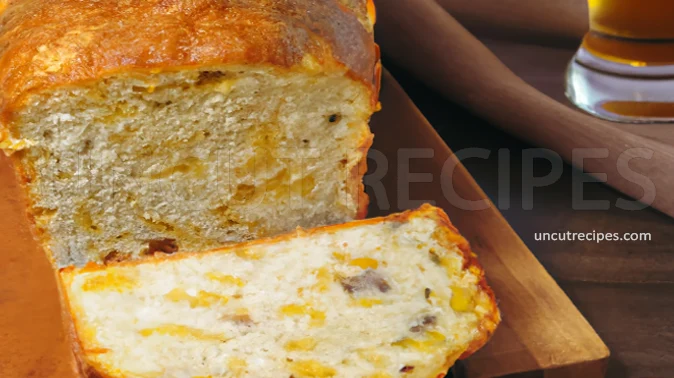
The late 20th century heralded the era of bread machines. With it came the innovation of incorporating varied and sometimes unconventional ingredients into bread. The Beer Cheese Bread, with its rich, robust flavors and unique texture, was a perfect candidate for adaptation. The bread machine offered a simplified and consistent approach to a bread that once may have required more intricate knowledge of fermentation and dough handling.
While beer and cheese separately hold vast cultural significance across many European cultures, their combined presence in bread is a celebration of both. In regions like Belgium, Germany, and the UK, where both beer and cheese have strong cultural footprints, the beer cheese bread acts as a gastronomic symbol of old-world flavors meeting new-world innovations.
The loaf, dense from the cheese and slightly tangy and aromatic from the beer, has graced many a festive table, especially in regions with strong beer cultures. Its presence is not just as a food item but as a conversation starter, a tale of history baked into its very fibers.
TIPS:
Cheese Quality: Opt for freshly grated cheeses over pre-shredded varieties. Pre-shredded cheeses often contain anti-caking agents that can affect the texture and meltability in the bread.
Beer Selection: The flavor profile of the beer can significantly influence your bread. Experiment with craft or artisanal beers, each offering a distinct taste, from a fruity IPA to a rich stout, depending on the flavor profile you aim to achieve.
Sponge Method: This allows for better flavor development and a more uniform crumb.
Method: Mix half the flour, all the beer, and yeast together. Let this mixture sit for an hour until it becomes frothy, then proceed with the recipe.
Cheese Infusion: Enhances the cheese flavor throughout the bread.
Method: Before adding the shredded cheeses, infuse them in the beer overnight in the refrigerator. Strain before warming the beer and cheese mixture, then add the cheese bits later as the machine mixes.
Crust Brushing Technique: This will give the crust a shiny finish, add an extra layer of flavor, and keep it soft.
Method: After the bread completes its baking cycle and is still hot, lightly brush the crust with a mix of melted butter and a teaspoon of the beer.
Recipe Information
Skill Level
|
Time 2h 30 Minutes |
Price
|
Serves 6 People |
| Healthiness |
Nutritional Information |
| Ratings (Add Rating & Review) |
Reviews 10 Reviews |
Ingredients:
-
3 cups Bread Flour
1.2 cups Beer
( room temperature )
1 cup Mild Cheddar
( shredded or diced )
1 cup Monterey Jack Cheese
( shredded or diced )
1 tablespoon Unsalted Butter
( room temperature )
1 tablespoon Sugar
1.5 teaspoons Salt
1 package Active Dry Yeast
Allergens
| Dairy | Gluten | Sulphites |
Directions:
Preparing the Beer and Cheese Mixture:
01 - Using either your stovetop or microwave, gently warm the beer and Milkd Cheddar cheese together. The goal is to have them just warm, so there's no need for the cheese to fully melt. Give the mixture a good stir to ensure they're combined well.
02 - Carefully pour this blended mixture into the bread machine pan. If you touch the mixture and it feels too hot, let it sit for a moment until it cools down to a warm temperature – this is crucial as overly hot liquids can affect the yeast's function.
Completing the Bread Preparation:
03 - Now, add the rest of the ingredients specified in your beer bread recipe to the bread machine pan.
04 - Navigate to the settings on your bread machine and select the 'white bread' or 'basic' option, depending on your machine's labels.
05 - With everything in place, confidently press the 'start' button. As the machine works its magic, anticipate a freshly baked loaf of delicious beer bread!
Cooling and Storing Your Bread:
06 - Once the baking cycle is complete, wearing oven mitts, carefully remove the bread pan from the machine. Gently turn the pan upside down to release the loaf onto a wire rack.
07 - Allow the bread to cool completely on the wire rack for about 1 to 2 hours. This ensures that the inner moisture settles and the crust achieves its perfect texture.
08 - Once cooled, slice the bread using a serrated bread knife for best results. Serve and savor the unique flavors of your beer bread!
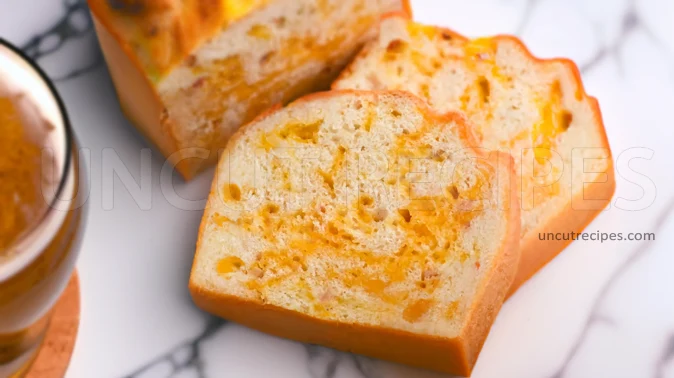
Notes:
Storage: To maintain freshness, store your beer cheese bread in an airtight container or bread box. If you plan to consume it within a day, room temperature is fine. longer storage, you can freeze the bread, wrapped in plastic wrap and then in aluminum foil, for up to 2 months. Just thaw and reheat when ready to enjoy again!
Serving Suggestion: This bread is especially good when toasted and served with a pat of butter, or as a base for hearty sandwiches given its rich flavors.
Non-Alcoholic Version: If you prefer a non-alcoholic version, you can use non-alcoholic beer, though this may slightly change the bread's flavor profile.
Nutritional Information
( Per Portion )
|
Calories |
300 kcal (15%) |
| Total Carbohydrate | 45g (15%) |
| Cholesterol | 35mg (12%) |
|
Total Fat |
8g (12%) |
| Saturated Fat | 5g (25%) |
| Polyunsaturated Fat | 0.5g (2%) |
| Monounsaturated Fat | 2g (13%) |
| Trans Fat | 0.2g |
| Fibers | 2g (8%) |
| Protein | 10g (20%) |
| Sugar | 2.5g (10%) |
|
Vitamin A |
200 IU (4%) |
|
Vitamin B1 (Thiamin) |
0.3mg (20%) |
| Vitamin B2 (Riboflavin) | 0.2mg (15%) |
| Vitamin B3 (Niacin) | 3.5mg (22%) |
| Vitamin B5 (Pantothenic Acid) | 0.5mg (10%) |
| Vitamin B6 | 0.05mg (3%) |
| Vitamin B7 (Biotin) | 2mcg (7%) |
| Vitamin B9 (Folate) | 50mcg (13%) |
| Vitamin B12 | 0.6mcg (25%) |
| Vitamin C | 0.5mg (1%) |
| Vitamin D | 0.5 IU (0.08%) |
| Vitamin E | 0.5mg (3%) |
| Vitamin K | 3mcg (4%) |
| Choline | 25mg (5%) |
| Carnitine | 2mg |
|
Calcium |
250mg (25%) |
|
Chloride |
90mg (2%) |
| Chromium | 2mcg (5%) |
| Copper | 0.05mg (6%) |
| Fluoride | 0.02mcg (1%) |
| Iodine | 15mcg (10%) |
| Iron | 3mg (17%) |
| Magnesium | 20mg (5%) |
| Manganese | 0.5mg (25%) |
| Molybdenum | 5mcg (11%) |
| Phosphorus | 200mg (20%) |
| Potassium | 150mg (3%) |
| Selenium | 10mcg (18%) |
| Sodium | 600mg (25%) |
| Sulfur | 80mg |
| Zink | 1.5mg (14%) |
* Percent Daily Values are based on a 2,000 calorie diet. Your daily values may be higher or lower depending on your calorie needs.
** Nutrient information is available for all ingredients in this recipe. Amount is based on available nutrient data collected from all over the internet.
(-) Information is not currently available for this nutrient. If you are following a medically restrictive diet, please consult your doctor or registered dietitian before preparing this recipe for personal consumption. |
| Written by: Uncut Recipes | Disclaimer |







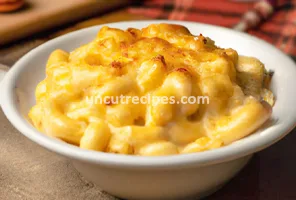


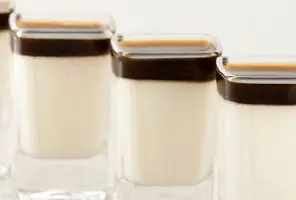


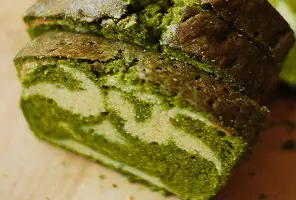




September 22, 2023
This bread is something else! It tastes amazing. I'm grateful you shared such an awesome recipe. When I made it, even my picky eater nephew wanted seconds!